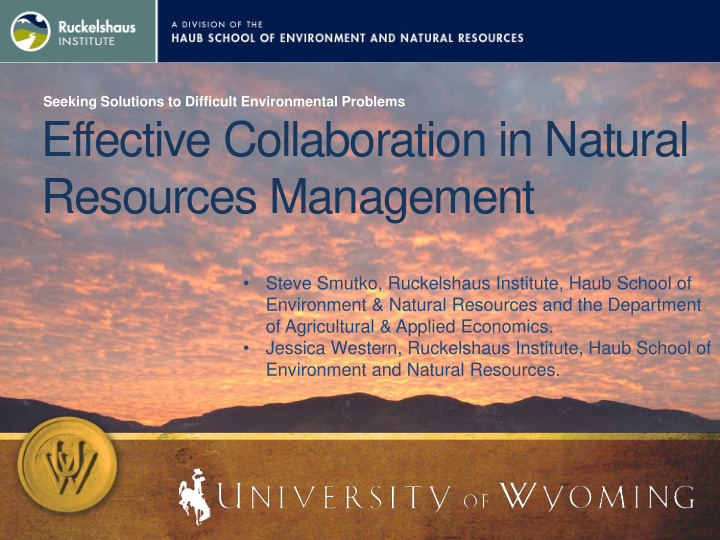



Seeking Solutions to Difficult Environmental Problems Effective Collaboration in Natural Resources Management • Steve Smutko, Ruckelshaus Institute, Haub School of Environment & Natural Resources and the Department of Agricultural & Applied Economics. • Jessica Western, Ruckelshaus Institute, Haub School of Environment and Natural Resources.
Why bother? • Landscape scale issues. • Very few decisions in natural resources are made in a vacuum. • Not sure of the extent of the problems or the extent of the solutions…both are generally unknown • Maximize gains among all parties
Problem Complexity • Multiple parties, issues, time considerations • Conflicting value orientations • Policy and precedent • Science & technology (cognitive demands) • Uncertainty and ambiguity • High stakes
Collaboration • The process and structures of public policy decision making and management that engage people constructively across the public, private and nonprofit sectors in order to carry out a public purpose that could not otherwise be accomplished. Adapted from Emerson, K., Nabatchi, T., & Balogh, S. (2011). An Integrative Framework for Collaborative Governance. Journal of Public Administration Research and Theory .
Collaboration & Negotiation • Two sides to the same coin. • Collaboration is ‘negotiation’ among many parties. • It is FOTE: a Full, Open and Transparent Exchange. • The result is a collaborative decision. • Negotiation in this sense is a positive-sum game, not a zero-sum game. • To make positive gains, one must help other stakeholders make gains too.
Collaboration is Difficult • We often position ourselves for a zero-sum outcome • We lack a systematic approach for preparing and conducting collaboration • We are limited by institutional and cultural norms • We are trapped by ego and emotion
But, Very Possible Platte Valley, Wyoming Range and Mule Deer, Sage Grouse, Black Hills forestry, Governor’s Task Force on Forests – many examples of successful collaboration in WY. Requirements: • Recognize possibilities for mutual gain • Help constituents understand how collaboration works and can benefit them. • Listen, ask questions, find common ground. • More than any facilitator, you can make this successful.
THE COLLABORATIVE PROCESS
In any collaboration, 3 domains are in play: Process Substance Relationships
Collaboration is a Negotiation Strategy High Accommodating Collaborative Lose to win Win - win Compromise Importance of Split the difference Relationship Competitive Avoiding Lose - lose Win - lose Low Importance of Low High Outcome
CREATING VALUE John’s direction of satisfaction Accommodate/Compete Solution Possibilities Frontier Collaborate Integrative Solution Benefits to John Many options exist, some are better than others Compromise Distributive Solution ZOPA Accommodate/Compete John’s reservation value Avoid/Ignore Angela’s direction of Benefits to Angela satisfaction Angela’s reservation value
The Challenges 1. Engaging in a logical and robust consensus building process while accommodating conflict. 2. Creating value for all stakeholders
Principled Negotiation • Separate the people from the problem • Focus on interests not positions • Generate options for mutual gain • Evaluate options using objective criteria
A Consensus-Building Process Step 3: Step 4: Step 1: Step 2: Identify Identify Identify Identify Options Trade-offs Interests Problems The Trade-offs that meet as many interests as possible form the Agreement.
Step 1: Identify Problems • Learn how different stakeholders view the problem. • Avoid assumptions. • Will allow participants to gain insight into what options are going to be most feasible. • Allows participants to gain clarity on the scope of work ahead.
Step 2: Identify Interests • Learn what is important to different stakeholders and why. • Will allow participants to gain insight into what trade-offs are going to be most feasible. • Allows participants to gain clarity on where there is the most disagreement and where there appears to be more agreement.
Step 3: Identify Options • Identify all the possible solutions that exist. • During option generation, participants learn in more depth from eachother about the issue and the possibilities.
Step 4: Identify Trade-Offs • Explore the pro’s and con’s of all options. • Explore the level of agreement with all options. • Find as many options as possible that meet as many interests as possible • This is the hard work. • This is where agreement will emerge if it exists.
Collaboration Drivers • Leadership • Consequential incentives • Interdependence • Uncertainty
Why bother? • Landscape scale issues. • Very few decisions in natural resources are made in a vacuum. • Not sure of the extent of the problems or the extent of the solutions…both are generally unknown. • You may end up with a solution that no one could have predicted and is a win-win.
Questions?
Recommend
More recommend